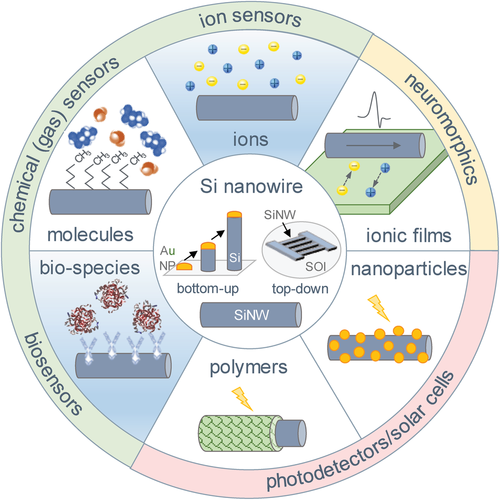In the pool of nanostructured materials, silicon nanostructures are known as conventionally used building blocks of commercially available electronic devices. Their application areas span from miniaturized elements of devices and circuits to ultrasensitive biosensors for diagnostics. In this Review, the current trends in the developments of silicon nanowire-based devices are summarized, and their functionalities, novel architectures, and applications are discussed from the point of view of analog electronics, arisen from the ability of (bio)chemical gating of the carrier channel. Hybrid nanowire-based devices are introduced and described as systems decorated by, e.g., organic complexes (biomolecules, polymers, and organic films), aimed to substantially extend their functionality, compared to traditional systems. Their functional diversity is explored considering their architecture as well as areas of their applications, outlining several groups of devices that benefit from the coatings. The first group is the biosensors that are able to represent label-free assays thanks to the attached biological receptors. The second group is represented by devices for optoelectronics that acquire higher optical sensitivity or efficiency due to the specific photosensitive decoration of the nanowires. Finally, the so-called new bioinspired neuromorphic devices are shown, which are aimed to mimic the functions of the biological cells, e.g., neurons and synapses.

In the pool of nanostructured materials, silicon nanostructures are known as conventionally used building blocks of commercially available electronic devices. Their application areas span from miniaturized elements of devices and circuits to ultrasensitive biosensors for diagnostics. In this Review, the current trends in the developments of silicon nanowire-based devices are summarized, and their functionalities, novel architectures, and applications are discussed from the point of view of analog electronics, arisen from the ability of (bio)chemical gating of the carrier channel. Hybrid nanowire-based devices are introduced and described as systems decorated by, e.g., organic complexes (biomolecules, polymers, and organic films), aimed to substantially extend their functionality, compared to traditional systems. Their functional diversity is explored considering their architecture as well as areas of their applications, outlining several groups of devices that benefit from the coatings. The first group is the biosensors that are able to represent label-free assays thanks to the attached biological receptors. The second group is represented by devices for optoelectronics that acquire higher optical sensitivity or efficiency due to the specific photosensitive decoration of the nanowires. Finally, the so-called new bioinspired neuromorphic devices are shown, which are aimed to mimic the functions of the biological cells, e.g., neurons and synapses.
